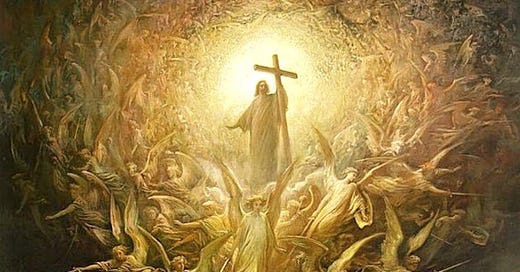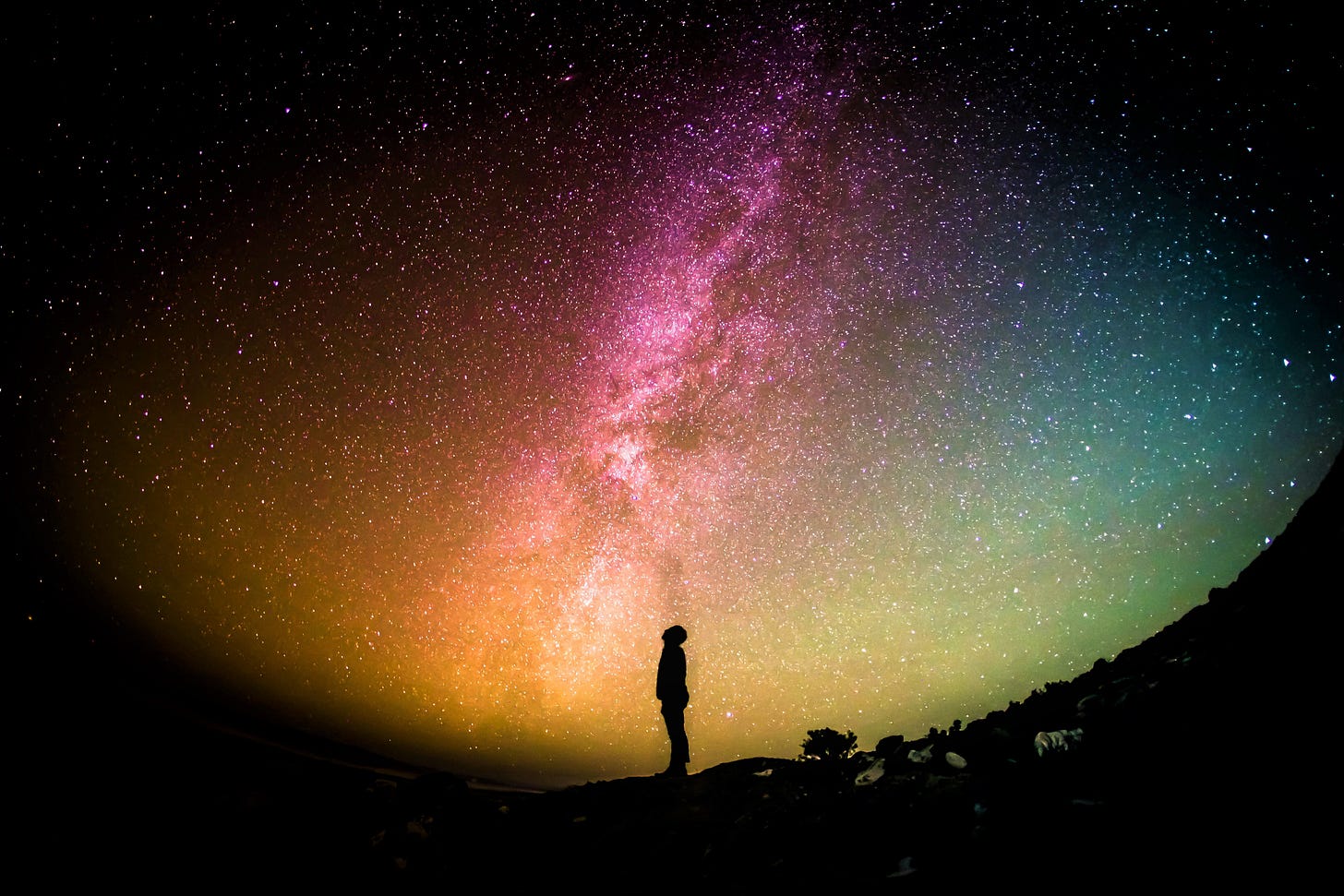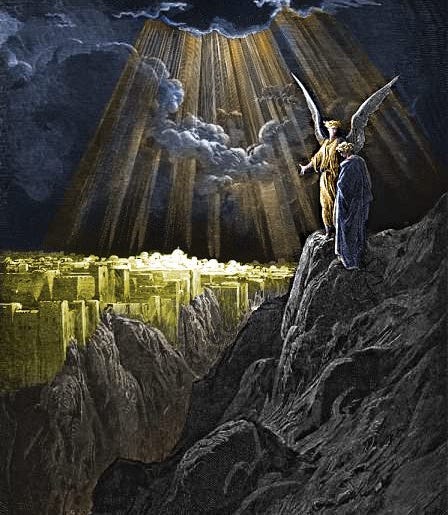Gustave Dore, Wikimedia Commons
“The Earthly City and the City of God”
“Two cities have been formed by two loves: the earthly by the love of self, even to the contempt of God; the heavenly by the love of God, even to the contempt of self.” St. Augustine, The City of God, XIV, 28.
In this post I have expanded upon some earlier reflections that were part of my series: 7 Reasons Why you Should Read the Book of Revelation.
Beyond St. John’s powerful visions of the vast, cosmic struggle between the forces of good and evil, the Prophet of Patmos invites us to reflect upon that inner, spiritual struggle at work within the human heart.
The Battle Between the Forces of Good and Evil
It is important to appreciate how within the context of the interplay of opposing symbols in the Apocalypse — images of the throne of God and the throne of Satan (Rev. 2:13), of heaven and hell, of angels and devils, of the New Jerusalem and the city of Babylon — John wants to offer his audience a deeper insight into this passing world and their place in it.
And through the Book’s rhetoric or “art of persuasion,” the faithful are called to choose sides: to choose God and Christ, and so to begin – now – to stand with the Angels and Saints in heaven.
It becomes clear that John’s art of persuasion involves the filtering out of most shades of grey, as he tells his tale of two cities and of the invisible, spiritual struggle that rages between the armies of angels and the forces of darkness (Rev. 12:7).
In a manner reminiscent of the choice set before the people of Israel in Deuteronomy chapter 30, and in the early Christian treatise The Teaching of the Twelve Apostles (or Didache), John calls the Churches of Asia Minor to choose between the two ways: of “life and death,” of “blessing and curses” (Deut. 30:11–20; cf. Didache 1:1); to choose between the way of light and the path to darkness (cf. The Epistle of Barnabas 18–20).
“Worship God!” (Rev. 19:10)
John exhorts his audience to worship God and God alone, to choose sides in the struggle between good and evil, and so to seek entrance into the new creation as the old order rapidly fades.
Ultimately, the audience is called to choose between two fires: the fire of the Holy Spirit that transforms the victors into “gold refined by fire” (Rev. 3:18), or the “lake of fire” reserved for those who have allied themselves with the forces of darkness that wage war against the will of God (Rev. 20:14–15).
“And War Broke Out in Heaven,” Rev. 12:7
At the same time, as the war in heaven between Michael the Archangel and Satan rages on, John calls us not to lose our focus upon the struggle taking place within the human heart, and that “other force” at work within us, as St. Paul cautions in Romans 7:23.
Indeed, John calls us to listen to what the Spirit is saying to the “seven churches,” to look within, “to wake up” (Rev. 3:2), to struggle actively against that “other law at work within me that wages war against the law of my mind” (Rom. 7:23). John calls the faithful of the seven churches of Asia Minor - and us along with them - to repent and to give brave public witness to the values of the Gospel, against the values of the world empire (Rev. 2-3).
Yes, God will “make all things new,” but as St. Bonaventure observes:
Into this New Jerusalem no one steps unless it first descends into the heart by grace. The Journey of the Mind to God, 4.4
So it is that the struggles at work at a macrocosmic level are also at work at a microcosmic level. The Kingdom is already in the process of being won and lost every day, in the here and now, in the ongoing spiritual struggle that rages within.
“Our Hearts Are Restless Until They Rest in God” - St. Augustine
That the Book of Revelation has a great deal to say concerning spirituality and the inner life has long been recognized, as scholars do well to observe. For
. . . the battle between good and evil takes place not only in the arena of history but also in human hearts. [1]
The vast cosmic canvas upon which the story of the Apocalypse is painted should therefore also be considered from the perspective of St. John’s own inner life, and the spiritual and “psychological explosion” out of which his visions emerge. [2]
As I have said on other occasions, beyond the powerful visions of a new heaven and a new earth, the Apocalypse narrates a compelling account of one early Christian prophet’s experience of “paradise now.” [3]
And so, John leads us to reflect upon the mystery of spiritual struggle in its interior dimension. For in the words of the fourth-century Syrian monk, known as Pseudo-Macarius:
The heart itself is but a small vessel, yet there also are dragons and there are lions; there are poisonous beasts and all the treasures of evil. And there are rough and uneven roads; there are precipices. But there is also God, also the angels, the life and the Kingdom, the light and the Apostles, the treasures of grace – all things are there. Homily 43.7
“Putting on the New Self”
Our faith teaches us that the human person has been created in the image and likeness of God. The soul is “capable of God” (or capax Dei in the words of St. Augustine). Our faith calls us to a profound spiritual renewal, so as to
Put on the new self, created to be like God in true righteousness and holiness (Eph. 4:24).
And we do so by entering into the spiritual struggle that leads to the casting off of the “old self,” as we strive in all circumstances to enter ever more deeply into the life of the Spirit, and in so doing to become a new creation in Christ.
And of what use are the victories on the battlefield if we are ourselves are defeated in our innermost personal selves? - St. Maximillian Kolbe
Indeed, a magnificent vision of the human person emerges in the Bible and extra-biblical literature, as well as in the writings of Origen, St. Gregory Nazianzen, St. Gregory of Nyssa, St. Thomas Aquinas, and in later Christian reflection. The human soul comes to be spoken of within these lines of reflection as a “microcosm,” a world in miniature (parvus mundus). [4]
Here, the fullness of being (magis esse) consists in striving to discover, to aspire toward, and to recover one’s deepest identity as contained within the infinite mystery of God. This ideal stands in stark contrast to the diminished state of “privation of the being” (minus esse) of those who have defected from, ignore, or are simply no longer able to perceive their own higher calling and destiny. [5]
The Seer’s portrait of the human person offers a powerful corrective in our deconstructionist era that has lost sight of the transcendent God, and in so doing, has lost sight of the greatness of the human person created in the image and likeness of God. As the universe gives way to the metaverse, ours is in many ways a new dark age that risks reducing the human person to a bio-engineered “soul-less machine” or “hackable animal.”
So it is that John invites us to consider our own attitudes toward the political, economic, social, and technological forces that shape the globalized postmodern, post-national, post-truth, and post-human world in which we live.
Photo by Greg Rakozy on Unsplash
Living as Temples of the Holy Spirit
John’s vision of the open door to heaven invites us, then, to contemplate the mystical dimension of apocalyptic literature. For, again, far beyond visions of “the end of the world,” the Apocalypse conveys a powerful and inspiring message concerning the soul’s longing for paradise regained, as we live out our lives in the light of Christ’s return at the end of time (Lk. 21:28).
Much more than “visions of the end,” the exiled prophet of Patmos offers us visions of the “open heaven,” as we are led to contemplate the relationship between the cosmic and the personal, “the great world . . . within the small” and “the inner theater of the Christian soul.” [6] For ultimately, John’s visions have been granted by the Holy Spirit to comfort, console and to strengthen the faithful during a time of crisis.
The mythic, macrocosmic perspective at work in Revelation’s electric world of vision finds its counterpart in the personal, interior struggles of the individual who strives to live in accord with the promptings of the Holy Spirit. Origen comments that the person who prays for the arrival of God’s heavenly Kingdom
. . . prays properly to have it within themselves. For God reigns in each of His holy ones; and dwells within that person as in a well-ordered city.
Indeed, he goes on to add that
There should be in us a kind of spiritual paradise where God may walk and be our sole ruler with His Christ. [7]
St. Leo the Great observes
If we are indeed a temple of God and if the Spirit of God dwells within us, then what every believer has within their soul is greater than what they admire in the sky (cf. 1 Cor 3:16). Sermo in Nativitate Domini, 7.2.6
And again, although the narrative of the Book of Revelation is cast in cosmic terms and epic proportions, it ultimately invites us to contemplate the spiritual battle at work within the human heart. St. Peter reminds us of the great importance of prayer at all times:
"Now, the end of all things is at hand.
Therefore, be of sound mind, and watching in prayer." 1 Peter 4:7
Becoming a New Creation in Christ
The journey of the soul to God involves the mystery of the spiritual struggle in which the soul — created as it is in God’s own image and likeness—strives to leave behind the life of sin that obscures the divine image within us (Rom. 7:14ff).
St. Clare of Assisi invites us not only to follow Christ, but to become a mirror of Christ for others to see and follow.
So too, St. John Vianney reminds us that:
We are, each of us — like a small mirror — into which God looks in search of His own reflection.
And so, when God looks at us what does He find?
Does God see Himself reflected in us?
Are we living so as to reflect the light and love of Christ to others?
Are we doing so in such a way as to inspire them to live the Gospel?
Do we mirror Christ’s own light, love and mercy to our neighbour through our acts of kindness and works of charity?
Are we living as temples of the Holy Spirit?
Are we striving to make of our hearts a “well-ordered city,” in which God and Christ have been given their proper place at the very center?
Have we entered into the spiritual struggle to cast off the old self and to be renewed in the Spirit, so that the everlasting city may begin its descent into our hearts through the life of grace?
The New Jerusalem by Gustave Dore, photo by Chris Tolworthy
[1] Arthur W. Wainwright, Mysterious Apocalypse: Interpreting the Book of Revelation (repr. 1993; Eugene, OR: Wipf & Stock, 2001), p. 203.
[2] Edward Edinger, Archetype of the Apocalypse: Divine Vengeance, Terrorism, and the End of the World, ed., George R. Elder (Chicago: Open Court, 1999), p. 16.
[3] April DeConick, “What is Early Jewish and Christian Mysticism?” in Paradise Now: Essays on Early Jewish and Christian Mysticism (Atlanta: Society of Biblical Literature, 2006), p. 24.
[4] See comments by Henri de Lubac, The Drama of Atheist Humanism, trans. Edith M. Riley, et al. (San Francisco: Ignatius Press, 1995), p. 20–21.
[5] Philip Blond, Post-Secular Philosophy: Between Philosophy and Theology, (London: Routledge, 1998), p. 4.
[6] Alexander Golitzin, “Earthly Angels and Heavenly Men: The Old Testament Pseudepigrapha, Niketas Stethatos, and the Tradition of Interiorized Apocalyptic in Eastern Christian Ascetical and Mystical Literature,” in Dumbarton Oaks Papers 55 (2001), p. 141 and literature cited.
[7] Cf., Origen, “A Treatise on Prayer,” Chapter XXV; PG 11, 495-499.






